The DFI 875P-T — LGA 775 meets Intel’s 875 chipset
Features
| CPU Support | All LGA775 processors |
| Northbridge | Intel® 875P chipset |
| Memory Support | Four 184-pin DDR sockets/ Supports dual channel (128-bit wide) memory up to 4 GB |
| AGP | 1 AGP 8x/4x slot |
| Southbridge | Intel® 82801ER I/O Controller Hub (ICH5R) |
| Audio | RealTek 6-channel audio CODEC |
| Audio Connectivity | S/PDIF-in/out interface |
| PCI | 4 PCI slots |
| IDE | Supports up to UltraDMA 100Mbps hard drives |
| IDE RAID | Not Supported |
| SATA | Supports two SATA (Serial ATA) interfaces which are compliant with SATA 1.0 specification (1.5Gbps interface) |
| SATA RAID | Supports RAID 0 and RAID 1 |
| Networking | Marvell 88E8001 Gigabit PCI LAN controller |
| USB | 4 x I/O USB 2.0, 2 connectors for 4 additional external USB 2.0 ports |
| FireWire | Supports two 100/200/400 Mb/sec ports |
| Other I/O |
1 mini-DIN-6 PS/2 mouse port |
| Voltages |
|
Layout
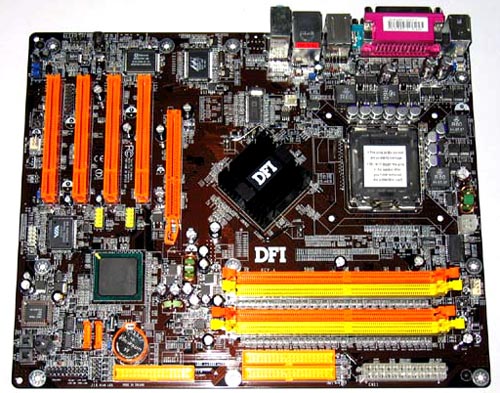
DFI arguably makes the best looking boards on the market. Using a jet black PCB, every connector would stand out easily even if DFI didn’t use flourescent orange and yellow. Along with the included matching cables, this board should should look absolutely incredible with a cold cathode light or two in your case.
Moving on from appearance to the actual layout of the board, you should immediately notice the 875P-T is like every other board DFI has released, well organized and very simple. This is often an understated aspect of motherboards, but also one of the most important for a few reasons. One key to an uncluttered case is a well organized board, and the 875P-T is extremely well organized. While most boards are basically the same in their layout, the variables usually are the 24 pin ATX power connector, the IDE/FDD connectors, and the proximity of components to the processor socket. Something that immediately stands out with this board is that everything is nicely grouped together in a way that maximizes both orginization and air flow. The DIMM slots, ATX connector and IDE connectors are all nicely aligned together along the upper right side of the board.
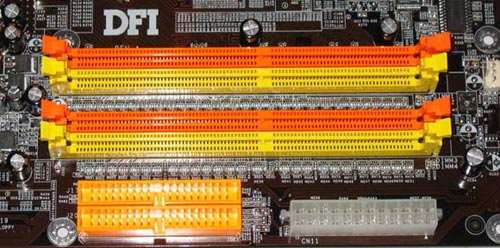
DFI placed the 24 pin ATX connector in the far upper right corner of the board, the best location possible to allow both easy access from the PSU and to stow extra cable behind the board or empty optical drive bays. Next DFI stacked the IDE/FDD connectors along the edge of the board to minimize cable clutter, though this really shouldn’t be an issue with the included rounded IDE/FDD cables.
Last is probably the most important design feature: The 875P-T leaves ample room around the CPU to accomadate just about any aftermarket heat sink or water cooling apparatus on the market. To me at least, the disappointing aspect of many high end boards has been the layout around the CPU socket. How many times have you purchased a very large aftermarket heatsink like the XP-120, only to see capacitors or the NB chipset cooler get in the way?
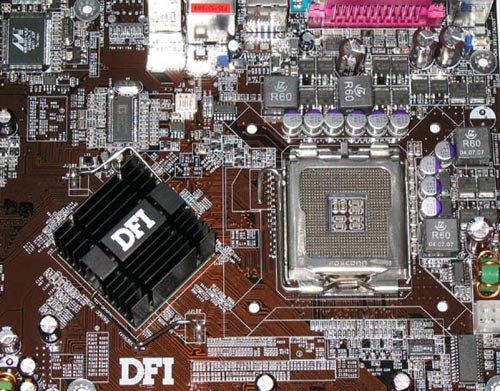
The Intel 82875P northbridge chipset is passively cooled with a large black heatsink, but given the fact that this board is marketed to the enthusiast, I would have preferred to see an active cooling solution. DFI did move the NB chipset slightly down the board, leaving enough room for any CPU cooler.
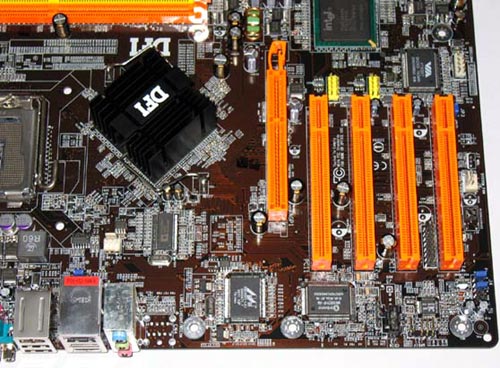
To create more space on the board, as well as make for better arrangement, DFI removed one PCI slot, though four should be more than sufficient. By doing this, DFI created extra room between the AGP slot, the NB, and the DIMM slots. This should allow users to easily install and remove components such as system memory or an AGP video card without issue. Another benefit of this extra room is that users should have no problem using an aftermarket video card cooler such as Arctic Cooling’s VGA Silencer.
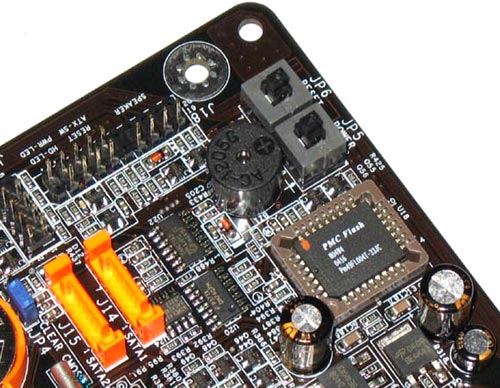
In the lower right quarter of the board DFI placed the clear CMOS jumper in an extremely accessible area right beneath the battery, and right above the two included SATA connectors (more on these in a minute). In the bottom right corner, DFI placed a power and reset switch. These are an incredible feature that I wish more board makers would include. While these aren’t necessary to the casual user, to the gaming or overclocking enthusiast (or people like myself who test equipment for a living) they are invaluable, allowing you to run the board on an open test bench or in the case without having to hook up all the front panel connections.

DFI chose to include the Marvell 88E8001 Gigabit PCI LAN controller and the Realtek ALC650 audio chip, which offers 6-Channels of dedicated audio, along with the S/PDIF in/output interface. Neither of these are “cutting edge” technology, but both are decent enough components that are more than adequate. Moving on to the I/O port, this board includes four USB 2.0 ports, a IEEE 1394 port, a LAN port, and the standard audio ports. The 875P-T also includes connectors on the board itself which allow 4 more USB 2.0 connections, for a total of eight, and another IEEE 1394 connection, for a total of two.
Layout Thoughts:
One issue I did have with this board’s layout was the placement of the 3 pin fan connectors. the CPU fan connector could have been placed closer to the CPU socket, while the centrally located second fan connector (usually used for the PSU fan) seems a little out of place on the board. I think DFI would have been better served using the CPU fan connector for the PSU fan, while moving the second fan connector slightly closer to the CPU socket. Lastly, DFI placed the system fan connector on the very bottom of the board near the center — right under the bottom PCI slot. To me this is a little cramped, but these are very minor gripes, right?
A more serious issue I had with the 875P-T was the inclusion of only two SATA connectors. Without using a PCI controller card, users are limited in their options either to a single two disk RAID array, or two independent SATA drives. Now with the release of SATA optical drives, this board could suffer a serious bottleneck in the near future.
Other than these two issues, I thought the overall layout of the DFI 875P-T was very clean and well thought out.

Comments are closed.